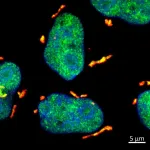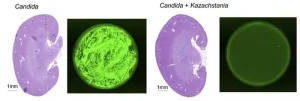(Press-News.org) The use of antipsychotics during pregnancy isn’t linked to childhood neurodevelopmental disorders or learning difficulties, UNSW Sydney-led study shows – giving assurance to those concerned about continuing their medications during pregnancy.
Antipsychotics – a branch of medication designed to treat schizophrenia and bipolar disorder – are important tools for mental health care management. They work by blocking the effect of dopamine, which can help reduce psychotic symptoms such as hallucinations or delusions.
These versatile medications are also widely used for other mental health conditions and developmental disorders, like anxiety, depression, autism spectrum disorder, and insomnia.
But many women and pregnant people using these medications may feel concerned about the potential risks they pose to their unborn baby.
A new international study led by UNSW Sydney, published today in eClinicalMedicine, tracked the long-term risk of a child developing neurodevelopmental disorders and learning difficulties after being exposed to antipsychotics in the womb.
The findings show there’s little to no increased risk of the exposure leading to intellectual disability, poor academic performance in maths and language, or learning, speech and language disorders.
“The findings are really reassuring for both women managing these psychiatric conditions during pregnancy and their providers,” says Dr Claudia Bruno, a pharmacoepidemiologist based at UNSW’s School of Population Health and lead author of the study.
“There’s no increased risk when taking the medication during pregnancy, not only for the specific neurodevelopmental disorders that we looked at, but also ADHD and autism as shown in our team’s previous studies.”
This research is the most comprehensive study on antipsychotics and neurodevelopmental outcomes to date: it pulls together nationwide data from Denmark, Finland, Iceland, Norway, and Sweden into a large sample size of 213,302 children born to mothers with a diagnosed psychiatric condition, 5.5 per cent (11,626) of which were prenatally exposed to antipsychotics.
These five Nordic countries all have similar health and education systems and keep detailed data on birth records, filled prescriptions, and diagnoses from inpatient and outpatient specialist care, as well as antenatal care. The researchers teamed these data with results from the children’s first standardised national school test (similar to Australia’s NAPLAN tests), which happens between the ages of 8-10.
“It’s reassuring that everything points to the same ‘no major indication’ of increased risks overall,” says Scientia Associate Professor Helga Zoega, senior author of the study and pharmacoepidemiologist, also based at UNSW’s School of Population Health.
“The study builds on our team’s previous work that looked at birth outcomes, including serious congenital malformations, where we’ve seen similar null results.
“I think it’s important to get excited about null results because this is essential information for the management of serious mental health conditions in pregnancy. It’s as equally important as finding an increased risk of outcomes.”
A gap that big health data is trying to fix
While this study is part of a growing body of research about medication safety in pregnancy, there’s still a lot left in this field to discover, says A/Prof. Zoega.
“This is a hugely understudied area,” she says. “Unfortunately, we know way too little about medication safety during pregnancy.”
One of the reasons so little is known about medicines and pregnancy is that it’s simply not feasible – or in many cases, ethical – to conduct randomised clinical trials on pregnant women. The potential risks of testing or withholding treatment to the unborn child and mother or pregnant person is often too great.
That’s where harnessing big data can step in – although the research isn’t as simple as looking at the raw data alone.
For example, women treated with antipsychotics during pregnancy were more likely to smoke, have higher BMIs, lower education levels, to be older (35 years or more) and use other medications during pregnancy compared to women who didn’t take antipsychotics during pregnancy – all of which are risk factors that can potentially impact birth outcomes.
These circumstances – called ‘confounding factors’ – are accounted for in observational research using careful study design and complex adjusted risk models to make sure the results show the impact of the medication alone.
“These types of studies are methodologically tricky, and can take a long time to do,” says A/Prof. Zoega. “This study has been in the making for almost 10 years now.
“We already know these women are dealing with psychiatric conditions, and by genetic default, their children would be more likely to have psychiatric or neurodevelopmental outcomes. But we’re focused on the risks and benefits of the medication treatment in pregnancy, so we use methods to make the comparison groups as similar as possible.”
The researchers also strengthened their findings by slicing up the data to take a closer look at whether individual medications, trimesters of exposure, and siblings carried higher risk levels.
While one antipsychotic, chlorpromazine, showed potential increased links to language and speech delays, these findings were based on small sample sizes of 8-15 children, so more research is needed to investigate this potential link.
Other than this anomaly, the results supported the finding that there was little to no increased risk of children prenatally exposed to antipsychotics developing neurodevelopmental disorders or learning difficulties.
Looking ahead
Dr Bruno is currently involved in two related studies on prenatal medication use and pregnancy outcomes. One explores if there is a relationship between the use of antiseizure medications during pregnancy and child school performance, and the other examines whether taking ADHD medication use and discontinuation during pregnancy on child health outcomes.
But she sees many avenues for future research to build on this work, including harnessing more Australian big health data.
“There’s so much to learn about medication safety in pregnancy,” says Dr Bruno. “These women are typically excluded from clinical trials, so there’s a real lack of data or evidence.
“While these results are highly generalisable to women in Australia, we now have real-world linked Australian data that can start contributing to large-scale international studies like this one which we’re very excited for.”
A/Prof. Zoega co-leads an international research collaboration called International Pregnancy Drug Safety Study (InPreSS), which investigates the safety of medication in pregnancy. She says there’s plenty to do in this space.
“Antipsychotics are only one class of medications, and we already know that up to 80 per cent of women use at least one prescription medicine during pregnancy. Most often, there’s little or no guidance on safety.
“There are so many unanswered questions that there’s enough for a lifetime of research.”
END
Study eases concern at antipsychotics use in pregnancy
The use of antipsychotics during pregnancy isn’t linked to childhood neurodevelopmental disorders or learning difficulties, UNSW Sydney-led study shows – giving assurance to those concerned about continuing their medications during pregnancy.
2024-03-18
ELSE PRESS RELEASES FROM THIS DATE:
Peer-coaching helps socially marginalized individuals lower blood pressure
2024-03-18
For younger Black patients living in rural parts of the Southeastern United States, peer coaching is more effective than traditional clinical care in controlling high blood pressure, according to a new study led by investigators at Weill Cornell Medicine and NewYork-Presbyterian. The investigators learned that for people under age 60 who have persistently uncontrolled hypertension, the benefits of working with a peer health coach were equivalent to what would be expected from taking a low dose of blood pressure medication.
The findings were published March 18 in JAMA Internal Medicine. The randomized ...
Estimated childhood lead exposure from drinking water in Chicago
2024-03-18
About The Study: The findings of this study indicate that childhood lead exposure from drinking water is widespread in Chicago, and racial inequities are present in both testing rates and exposure levels. Machine learning may assist in preliminary screening for lead exposure, and efforts to remediate the effects of environmental racism should involve improving outreach for and access to lead testing services.
Authors: Benjamin Q. Huynh, Ph.D., of the Johns Hopkins University Bloomberg School of Public Health in Baltimore, is the corresponding author.
To access the embargoed study: Visit our For The Media website at this link https://media.jamanetwork.com/
(doi:10.1001/jamapediatrics.2024.0133)
Editor’s ...
How DHX9 stress granules protect daughter cells from UV-induced RNA damage
2024-03-18
Mothers and daughters have a strong bond, yet do you know that connections reminiscent of this close relationship extend all the way to the cellular level? During the process of cell division, new daughter cells inherit a mix of genetic material and other molecules from their mother cells. This inheritance includes both beneficial components, which can help them for a robust start in life, and potentially harmful mutations or damaged molecules, posing significant challenges for the newly born daughter cells. How daughter cells manage and ...
Discover BMB 2024 press materials available now
2024-03-18
Embargoed press materials are now available for Discover BMB, the annual meeting of the American Society for Biochemistry and Molecular Biology. Top scientists and educators in the field will gather at the meeting, March 23–26 in San Antonio.
Reporters are invited to attend an exciting lineup of in-person scientific sessions in San Antonio or access press materials electronically. Register now or find more information in the #DiscoverBMB newsroom. Please note that only a limited number of complementary on-site press passes will be issued, so advance registration is recommended.
Explore the schedule at a ...
Newly identified yeast could prevent fungal infections by outcompeting rivals, study suggests
2024-03-18
Researchers at the Weizmann Institute of Science in Israel have identified a yeast that could be used to prevent invasive candidiasis, a major cause of death in hospitalized and immunocompromised patients. The study, to be published March 18 in the Journal of Experimental Medicine (JEM), shows that the novel yeast lives harmlessly in the intestines of mice and humans and can displace the yeast responsible for candidiasis, Candida albicans.
Millions of microbial species live within or on the human body, many of them being harmless or even beneficial to human health. The microscopic yeast C. albicans is commonly found in the intestines ...
NIH studies find severe symptoms of “Havana Syndrome,” but no evidence of MRI-detectable brain injury or biological abnormalities
2024-03-18
EMBARGOED FOR RELEASE
Monday, March, 18,2024
10 a.m. EDT
Contact:
NIH Office of Communications and Public Liaison
NIH News Media Branch
301-496-5787
NIH studies find severe symptoms of “Havana Syndrome,” but no evidence of MRI-detectable brain injury or biological abnormalities
Compared to healthy volunteers, affected U.S. government personnel did not exhibit differences that would explain symptoms
Using advanced imaging techniques and in-depth clinical assessments, a research team at the National Institutes of Health (NIH) found no significant evidence of MRI-detectable brain injury, nor differences in most clinical measures compared to ...
Clinical, biomarker, and research tests among US government personnel and their family members involved in anomalous health incidents
2024-03-18
About The Study: In this exploratory study, there were no significant differences between individuals reporting anomalous health incidents and matched control participants with respect to most clinical, research, and biomarker measures, except for objective and self-reported measures of imbalance and symptoms of fatigue, posttraumatic stress, and depression. This study did not replicate the findings of previous studies, although differences in the populations included and the timing of assessments limit direct comparisons. ...
Neuroimaging findings in US government personnel and their family members involved in anomalous health incidents
2024-03-18
About The Study: In this exploratory neuroimaging study, there were no significant differences in imaging measures of brain structure or function between individuals reporting anomalous health incidents and matched control participants after adjustment for multiple comparisons. U.S. government personnel stationed internationally have reported anomalous health incidents, with some individuals experiencing persistent debilitating symptoms.
Authors: Carlo Pierpaoli, M.D., Ph.D., of the National Institute of Biomedical Imaging and Bioengineering in ...
Can used coffee grounds help clean up environmental toxins?
2024-03-18
Global coffee consumption generates millions of tons of spent coffee grounds each year, which can be damaging to wildlife and the environment. However, new research published in the Journal of Chemical Technology and Biotechnology reveals that spent coffee grounds could be repurposed to act as a powerful adsorbent of bentazone, a herbicide commonly used in agriculture that is highly neurotoxic.
In the study, investigators found that when they used zinc chloride to activate the carbon from spent coffee grounds, the activated carbon showed a 70% efficiency in bentazone removal. ...
Largest-ever map of universe’s active supermassive black holes released
2024-03-18
Astronomers have charted the largest-ever volume of the universe with a new map of active supermassive black holes living at the centers of galaxies. Called quasars, the gas-gobbling black holes are, ironically, some of the universe’s brightest objects.
The new map logs the location of about 1.3 million quasars in space and time, the furthest of which shone bright when the universe was only 1.5 billion years old. (For comparison, the universe is now 13.7 billion years old.)
“This quasar catalog is different from all previous catalogs in that it gives us a three-dimensional map of the largest-ever volume of the universe,” says map co-creator David Hogg, a ...
LAST 30 PRESS RELEASES:
When is it time to jump? The boiling frog problem of AI use in physics education
Twitter data reveals partisan divide in understanding why pollen season's getting worse
AI is quick but risky for updating old software
Revolutionizing biosecurity: new multi-omics framework to transform invasive species management
From ancient herb to modern medicine: new review unveils the multi-targeted healing potential of Borago officinalis
Building a global scientific community: Biological Diversity Journal announces dual recruitment of Editorial Board and Youth Editorial Board members
Microbes that break down antibiotics help protect ecosystems under drug pollution
Smart biochar that remembers pollutants offers a new way to clean water and recycle biomass
Rice genes matter more than domestication in shaping plant microbiomes
Ticking time bomb: Some farmers report as many as 70 tick encounters over a 6-month period
Turning garden and crop waste into plastics
Scientists discover ‘platypus galaxies’ in the early universe
Seeing thyroid cancer in a new light: when AI meets label-free imaging in the operating room
Neutrophil-to-lymphocyte ratio may aid risk stratification in depressive disorder
2026 Seismological Society of America Annual Meeting
AI-powered ECG analysis offers promising path for early detection of chronic obstructive pulmonary disease, says Mount Sinai researchers
GIMM uncovers flaws in lab-grown heart cells and paves the way for improved treatments
Cracking the evolutionary code of sleep
Medications could help the aging brain cope with surgery, memory impairment
Back pain linked to worse sleep years later in men over 65, according to study
CDC urges ‘shared decision-making’ on some childhood vaccines; many unclear about what that means
New research finds that an ‘equal treatment’ approach to economic opportunity advertising can backfire
Researchers create shape-shifting, self-navigating microparticles
Science army mobilizes to map US soil microbiome
Researchers develop new tools to turn grain crops into biosensors
Do supervised consumption sites bring increased crime? Study suggests that’s a myth
New mass spec innovation could transform research
Maternal nativity, race, and ethnicity and infant mortality in the US
Migration-related trauma among asylum seekers exposed to the migrant protection protocols
Jupiter’s moon Europa has a seafloor that may be quiet and lifeless
[Press-News.org] Study eases concern at antipsychotics use in pregnancyThe use of antipsychotics during pregnancy isn’t linked to childhood neurodevelopmental disorders or learning difficulties, UNSW Sydney-led study shows – giving assurance to those concerned about continuing their medications during pregnancy.


